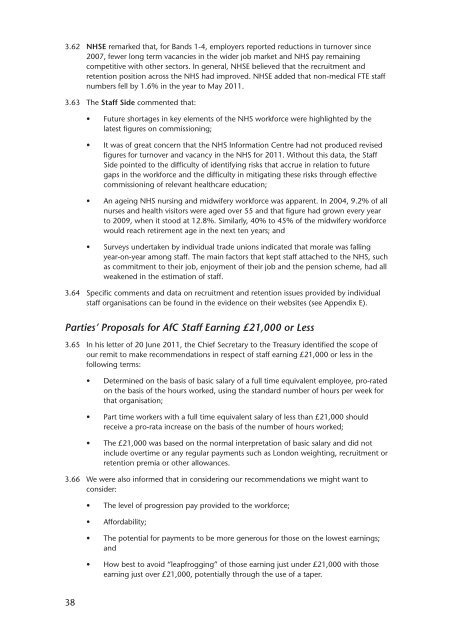NHS pay review body: twenty-sixth report 2012 - Official Documents
NHS pay review body: twenty-sixth report 2012 - Official Documents
NHS pay review body: twenty-sixth report 2012 - Official Documents
Create successful ePaper yourself
Turn your PDF publications into a flip-book with our unique Google optimized e-Paper software.
3.62 <strong>NHS</strong>E remarked that, for Bands 1-4, employers <strong>report</strong>ed reductions in turnover since<br />
2007, fewer long term vacancies in the wider job market and <strong>NHS</strong> <strong>pay</strong> remaining<br />
competitive with other sectors. In general, <strong>NHS</strong>E believed that the recruitment and<br />
retention position across the <strong>NHS</strong> had improved. <strong>NHS</strong>E added that non-medical FTE staff<br />
numbers fell by 1.6% in the year to May 2011.<br />
3.63 The Staff Side commented that:<br />
3.64<br />
38<br />
•<br />
•<br />
•<br />
•<br />
Future shortages in key elements of the <strong>NHS</strong> workforce were highlighted by the<br />
latest figures on commissioning;<br />
It was of great concern that the <strong>NHS</strong> Information Centre had not produced revised<br />
figures for turnover and vacancy in the <strong>NHS</strong> for 2011. Without this data, the Staff<br />
Side pointed to the difficulty of identifying risks that accrue in relation to future<br />
gaps in the workforce and the difficulty in mitigating these risks through effective<br />
commissioning of relevant healthcare education;<br />
An ageing <strong>NHS</strong> nursing and midwifery workforce was apparent. In 2004, 9.2% of all<br />
nurses and health visitors were aged over 55 and that figure had grown every year<br />
to 2009, when it stood at 12.8%. Similarly, 40% to 45% of the midwifery workforce<br />
would reach retirement age in the next ten years; and<br />
Surveys undertaken by individual trade unions indicated that morale was falling<br />
year-on-year among staff. The main factors that kept staff attached to the <strong>NHS</strong>, such<br />
as commitment to their job, enjoyment of their job and the pension scheme, had all<br />
weakened in the estimation of staff.<br />
Specific comments and data on recruitment and retention issues provided by individual<br />
staff organisations can be found in the evidence on their websites (see Appendix E).<br />
Parties’ Proposals for AfC Staff Earning £21,000 or Less<br />
3.65 In his letter of 20 June 2011, the Chief Secretary to the Treasury identified the scope of<br />
our remit to make recommendations in respect of staff earning £21,000 or less in the<br />
following terms:<br />
3.66<br />
•<br />
•<br />
•<br />
Determined on the basis of basic salary of a full time equivalent employee, pro-rated<br />
on the basis of the hours worked, using the standard number of hours per week for<br />
that organisation;<br />
Part time workers with a full time equivalent salary of less than £21,000 should<br />
receive a pro-rata increase on the basis of the number of hours worked;<br />
The £21,000 was based on the normal interpretation of basic salary and did not<br />
include overtime or any regular <strong>pay</strong>ments such as London weighting, recruitment or<br />
retention premia or other allowances.<br />
We were also informed that in considering our recommendations we might want to<br />
consider:<br />
•<br />
•<br />
•<br />
•<br />
The level of progression <strong>pay</strong> provided to the workforce;<br />
Affordability;<br />
The potential for <strong>pay</strong>ments to be more generous for those on the lowest earnings;<br />
and<br />
How best to avoid “leapfrogging” of those earning just under £21,000 with those<br />
earning just over £21,000, potentially through the use of a taper.
















